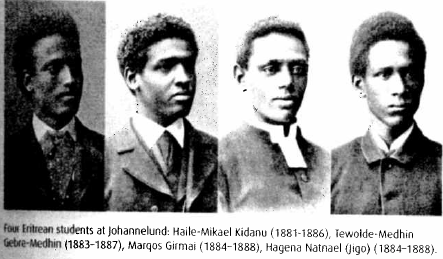
Compiled and researched by Resoum Kidane
Pt.1c. A short biographical information about educated Eritreans of the 1880s, 1890s, 1900s 1910s and 1920s generation.

Compiled and researched by Resoum Kidane
For centuries education in Eritrea was strongly based on religious schools (Stefanos, 1997) The religious education [1] run by the Coptic Church was for Christians and that run by the Mosque was for the Muslims. Since the introduction of Islamic religious education Tigrinya and Arabic languages have been the medium of teaching in schools. Perhaps the Turkish language was also used between 16th and 17th centuries as there was a dictionary which contains a glossary of eight Tigrinya -Turkish entries and Tigrinya- Arabic list of 380 words which was published during the Ottoman empire(Wende, 1994). The dictionary is available at the British Library.
Looking back to the history of education in Eritrea, from the middle of the 19th century there was a formal education system, the first Islamic school was established by the Ottomans in Tewalet in 1870 (Kidane, Eyob 2004) . Then other schools were opened by the Catholic Lazarists in Keren in 1872 [2 ]and Swedish Evangelican Missionaries (SEM)opened a boys’ school in Gheleb in 1889. By 1900 there were scholars who received their education from Islamic education and the Missionary schools, notably the father of Sheikh Ibrahim Mukhtar who obtained Islamic education, and the preacher Twelde Medhin, who was a student at Oslo in 1900. (Ghebreab, 2006. This section will provide a short biographical information about educated Eritreans who received their formal education between 1880s and 1940s .
1.Short personal history of some women fighters and their role in the struggle

Onesimus Nesib was born around 1856 near Hurumu in today's Illu Abbaboora. His original name was Hika, an Oromo name meaning "translator." His father died when he was four years old. Raiding tribesmen stole Hika from his mother and sold him as a slave, giving him a new name, Nesib.
Nesib was again stolen again from his owners and sold four times before Werner Munzinger (1832-1875), the vice-consul of the French Consulate, liberated him at Massawa on the Red Sea coast, where missionaries from the Swedish Evangelical Mission (SEM) had a boys' school headed by Rev. Bengt Peter Lundahl (1840-1885). Here, Nesib was given to Mr. W. Ahlborg (SEM) as a servant in October 1870 and become one of the students of that school. Mr. P. E. Lager (SEM) became his first teacher but Lundahl took over in December of the same year. A bright student, Nesib was soon converted and, when he was about sixteen, he was baptized on Easter Sunday (March 31, 1872), taking the Christian name Onesimus.
Even as a youth, he led a life of Christian devotion and completed his education in five years at Massawa. He volunteered to be a missionary hoping to evangelize the Oromo people some day in the future. His prayer was, "How long, O Lord, how long will it be before you send a preacher of the gospel there?"
In 1876, Lundahl sent Onesimus to Sweden for further education at the Theological Training Institute of Johannelund, where he stayed another five years. He returned to Massawa in the fall of 1881 ready to go out as a preacher of the gospel to his country. A classmate, A. W. Pahlman (1852-1931) came with him as a volunteer. As Onesimus had married nineteen-year-old Mehret Hailu, she also came along, accompanied by her father and three others on the journey to Wellega. This was the first "Oromo expedition" which failed from the outset because Emperor Menilik's raiding armies hindered peaceful travel southward. readmore
Negassi Melake COMMENT There are a lot of info that are not covered herein. Onesimus has contributed a lot in disseminating the gospel using the oromo language. He attempted to preach in oromofica in leqemt getting a permit from abba matewos of shewa. To his dimay this letter didn't serve him good. He was later defended by lij iyasu michael. Onesimus was also the first person who told am American how to prevent the spread of smallpox using the traditional means known in abyssinia.
Haile-Mikael Kidanu (1856-1919)
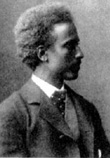
Took part in the First Oromo Expedition which started in 1877 and later studied Theology in Sweden from where he returned in 1886 He taught at Beleza, among other place.
Hagena Natnael (Jigo) -1888

Hagena was a Kunama. He was sent to Sweden for study in 1884–1888 but didn't finish his study and didn't return unlike the others. He passed away there. [contributed by Negassi Melake]. Negassi adds that N. Hagena was one of the five or four pupils taken to Europe. You have mentioned the father of Efriem. The other individual who was a Felasha from JENDA (Gonder) was Amanuel Tamrat. He played quite a lot in shaping the fate of Eriteria since 1944 in Addis Abeba and later in Asmara. His political and historical share is not to be undermined. Some deep study is needed to determine the damage done. I used primary and secondary sources to understand his share, but I feel that might not be sufficient.
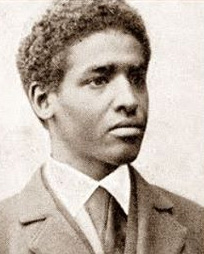
Tewolde-Medhin a student at Oslo in 1900, beginning in 1874, Täwäldä-Mädhin was educated at Gäläb at a school run by the Swedish Evangelical Mission. There, he and Dawit Amanuel (1862–1944) worked together to translate the New Testament into the Tigre language. Before it was completed, he was sent to Sweden for further study in 1883–1887, where he studied the Bible and Biblical languages, subjects that were later vital for his work in translation. He prepared a Tigre spelling book and a reading book that were published in 1889; that same year the Swedish Mission Press published the first installment of Tewolde-Medhin's translation, the Gospel of Mark (Ullendorff, 1968: 71). He was ordained in Asmara by A. Kolmodin, the first evangelical Eritrean to be ordained on the continent (1909). The entire New Testament in Tigre was published in 1902, a revised version later published in 1934 adopted spelling rules Täwäldä-Mädhin had advocated all along.[1] He later worked with Täwäldä-Mädhin Gäbru (1869–1960) and Dr. Karl Winqvist on the translation of the New Testament into Tigrinya, which was published in 1909, later working on the Old Testament, as well. In addition to his educational and translation work, he also served the churches as a pastor, teacher, and leader, becoming widely known and respected in Eritrea. [source wekipedia]. Keshi Tewolde- Medhin translated much of the Bible and assisted. J. Kolmodin in compiling an important collection of Eritrea folktales and oral history. [Connel page 509] Tewolde-Medhin spoke 12 languages: Tigryna, Tigre, Geez, Arab, English, Italian, German, Swedish, Greek, Latin, Amharic and [old Hebrew] Back to Table of Contents

Dawit was educated at Gäläb at a school run by the Swedish Evangelical Mission. There, he worked on Scripture translation, for some years together with Tewolde-Medhin Gebre-Medhin. In addition to translating, Dawit began a Tigre dictionary and collected many Tigre songs and proverbs. Many of these were later published by the German scholar Enno Littmann. Dawit was also active serving the church as a pastor and evangelist and was ordained in 1925. Wolde Mariam showed that Dawit was not given full credit for his contributions, some Swedes being given disproportionate credit.[1] source [source wekipedia
Senai W Andemariam also states that (Dawit Amanu’el (1862-1944) the task of beginning to translate the Holy Scriptures into the latter’s native language T?gre.Dawit was the first man from the Mänsa‘ group of the T?gre to be converted to Christianity by the Swedish Evangelical Mission (SEM), having been baptized, at the age of 15, by Lundahl in the Gäläb River on 8 July 1877.Dawit, described by Musa Aron as the father of theT?gre language began his work by translating the Gospel of Mark, with the assistance of qäshi(E) Täwäldä-Mädh ?n Gäbrä-Mädh ?n (1860–1930). Täwäldä-Mädh?n Gäbrä-Mädh?n, born in ‘Addi Täkkäläzzan, the home village of his mute mother ‘Agiga but with paternal links to the nearby village of Š?man?gus Ta??tay, was the son of qäshi(O) Gäbrä-Mädh ?n Täsfay (d.1876), the head priest of Tsä‘azzäga and one of the pioneers of the indigenous evangelical movement, and the nephew of qäshi(O) Haylä-ab Täsfay (c.1846–1876) who was undoubtedly the inspirational leader of the movement.A deacon of the Orthodox Täwah?do Church by the age of 12, Täwäldä-Mädh?n grew up under the tutelage of his father and his uncle, witnessing the fervent evangelical movement in his family. In 1874, he became a member of the evangelical congregation at Gäläb led by the memorable Finnish missionary Rev. Erik Emil Hedenström (1844–1904), who led the missionary work in theMänsa‘ regionread more

Qeshi Marcos was an Eritrean evangelist who graduated with distinction in 1889 from Johannelund Theological Institute. After his ordination, he came back to Eritrea. In December 1899, Qeshi Marocs married Regina Johansson in Eritrea. To make the story short, this union did not bode well with the then Italian governor Ferdinando Martini. He put pressure on the Swedish Evangelical Church. In order for the couple to work and remain in Eritrea, the Swedish missionaries were not to send Eritreans to Sweden for future studies source Issayas' blog.
According to the facebook "Childhood ChurchMY CHILDHOOD SCHOOL"
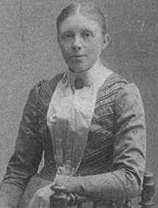
Qeshi Alazar wrote: Professor Adolph Kolmodin was the spiritual father and teacher of the first students (Qeshi Marcos Ghirmay, Onesimos Nesib, Natnael, etc.) from Massawa Mission School in Eritrea at Johannelund. At the same period, Professor Kolmodin was the leader of the Mission Board of the Evangelist Fosterlandsstiftelsen-EFS. It was during this time that a split broke out with a well known theology teacher at the University of Uppsala. After Adolph Kolmodin wrote a book, a split resulted between EFS and BV. Adolph Kolmodin was the father of Johannes Kolmodin who was well known in Eritrea. He was a student of classical semetic languages. He did research in Eritrea and compiled Zanta Hazegan Tseazegan.
Abba Teklemaryam Semharay Selim 1871-1942
Abba Teklemaryam Semharay outstanding scholar, advocate, linguist, mathematician and liturgist was born in Keren on 23rd August 1871 from Mr. Samharay and Mrs. Heyar Dabrom. Abba Teklemaryam Semharay died in Rome (Ospedale Fate Beni Fratelli) on 30th November 1942 and buried at the Vatican at Parrocchia di Santa Anna. The origin of his family was from the area of Shieb (East of Keren), situated nearby the ancient Monastery of Dabra-Sina (Eritrea) in a village called Shieb-Salaba. Apparently because of the continuous civil war, aggressions and persecutions, his families was forced to flee to Keren
In 1883, at the age of 12, Teklemaryam minor semharay joined the Catholic Seminary of Keren which was established by French Vincentians in 1869 where he received spiritual and intellectual formation for about 10 years during the time of Mons. Marcel Touvier. While studying in Keren, Teklemaryam minor semharay met eminent scholars and defenders of the Geez liturgy including Abba TekleHaimanot Taklazghi, the famous lingui st Debtera Kefleghiorghis of Ankober and strong language teacher Fr. Stahl P. who molded him in his profession. In addition, he studied printing in the vocational printing school established in Keren in 1878/9 and became the only person who could use it after the expulsion of the Lazzarist missionaries in 1894. Teklemaryam minor semharay was ordained in Keren on 27thMay 1893 by Mons. Jean Crouzet and assigned to be a Parish Priest of HalibMental. Later he was asigned to the Seminary of Keren where he taught for 16 years. He introduced Catholicism in his native area of Shieb-Salaba, Robto and served the ancient Church of Magarih and Bambi. In 1899, delegating the Vicariate of Eritrea, participated at the worldwide exposition hosted in Turin, Italy. In 1878/9, the Vincentians installed for the first time the printing press in Keren and Teklemaryam semharay was assigned to provide technical assistance and intellectual contribution mainly in finalizing and editing the first Catholic Mazmure Dawit (መዝሙረ ዳዊት) Breviary and translated from Italian Ne’us Meshaf De’qi Mariam (ንኡስ መጽሓፍ ደቂ ማርያም ) and published the outstanding Gheez grammar book entitled “ የግዕዝ ቋንቋ
ሰዋስው
”. In 1894 the French Vincentians were replaced by Italian Capuchins and Fr. Michele Carbonara was the first Italian Apostolic Prefect. In 1910 the Ap. Prefect transferred Abba Teklemaryam Semharay to Jerusalem at the Abyssinian hospice with the quality of rector and chaplain for the Catholic Geez rite pilgrims to Holy Land. Abba Teklemaryam Semharay established immediate contact with the Abyssinian Orthodox monks residing at Jerusalem which helped him to deepen more his knowledge and interest in Sacred Liturgy in relation with other Oriental Churches. In 1548 the first Catholic Geez Missal was published in Rome by monk Tasfazion and the second in Keren in 1890 by Fr. Coulbeaux. The European missionaries were undermining the Geez liturgy and the spirit of latinization was already diffused throughout the Vicariate. Mons. Marcel Touvier Vicar Apostolic of Eritrea (residing in Keren) and Guilelmo Card. Massaia (South Ethipia) had sent their proposal to the Congregation recommending the translation of Latin liturgical texts to the Geez language and to be utilized for pastoral activities. The Congregation, having examined the sensitivity of the proposal requested by Msgr. Crouzet (successor of Marcel Touvier), instructed a thorough study and consultation on liturgical books. As a result, a committee with five members was established and in 1890 the Geez Missal with 14 Anaphoras was published in Keren by Fr. Coulbeaux which Abba Teklemaryam Semharay had relentlessly criticized for introducing some Latin segments which was dividing the priests. readmore

Nefae Utman was born in 1882 in Gheleb and at the age of 12 years he joined the school. He finally succeeded and completed seventh grade, the highest level at that time, in about three years. His will and dedication enabled him to finish two grades in a year.
Shortly after that he started to work with a health expert missionary called Sudustrum in Gheleb. However, the year 1905 changed the life and future of the promising young Eritrean. 1907. Hearing the news of Nefae’s arrival, Littman immediately went to Sweden to welcome him. He took him to Germany and worked together with him for two years (1907 and 1908). Most of the books that documented the Tigre language oral tradition were written at this important time. These two years could be described as the ‘golden years’ in the history and development of the Tigre language, especially the written one. They both wrote four volumes on the subject, most of which were later published between 1910 and 1915 at Leyden University in Holland. They were also translated into English and German languages and were published at the same time.
The books depict almost every tradition of the Tigre society. Although they didn’t cover the vastly distributed native Tigre speakers, it was nonetheless a job well-done. The style of presentation and the content of what is written gave life to the oral tradition of the society. It describes the way they lived at different times and occasions—during celebrations and mourning; their names and the names of their livestock, etc.
In the volumes that followed, they included taboos, war cries, curses and blessings. There are also 717 traditional songs with 1400 stanzas. Based on the work they accomplished with Nefae, Littman and his long time colleague Maria Hophner prepared a Tigre-English-German dictionary in 1962. This 740-page book is one of the biggest works Littman contributed to the culture and language of the Tigre society. However, Littman passed away before seeing the publication of the book. After working together with Littman, Nefae wanted to return to his homeland. “I have longed for my beloved country. And of course my people and my parents have missed me a lot,” he told Littman. The German scholar didn’t want to upset Nefae. As a result, on 13 April 1909, Nefae sailed a ship to Massawa, which made its way through the Italian city of Napoli.
What happened then, however, only the almighty God knows. What happened to the smart and promising Nefae is still unknown – he just disappeared. No one has so far witnessed seeing Nefae alive or dead after that night. Although there are different hearsays about his disappearance, there is no evidence at all. Some say that the mafias of Sicily might have secretly dropped him in the sea; others argue that some Europeans, suspicious of his intelligence, might have killed him… before he made it home. on 13 April 1909, Nefae sailed a ship to Massawa, which made its way through the Italian city of Napoli.
What happened then, however, only the almighty God knows. What happened to the smart and promising Nefae is still unknown – he just disappeared. No one has so far witnessed seeing Nefae alive or dead after that night. Although there are different hearsays about his disappearance, there is no evidence at all. Some say that the mafias of Sicily might have secretly dropped him in the sea; others argue that some Europeans, suspicious of his intelligence, might have killed him… before he made it home.
Littman sent a telegram to Gheleb to tell them about the departure of Nefae and hence to welcome him in Massawa. The villagers and students who received the message rushed to give him a hero’s welcome. The students were eager to know about the other world, ‘the civilized world’; they were interested to hear the standard of education there. So, they took their drums and imitated local songs for the reception.
Finally, the ship arrived! The elders were allowed to enter the port but most of the youth were told to stay outside. A number of white people appeared but not a black ‘habesh’. His relatives were confused and worried at the same time. So, they asked where the boat was from. It was the right one, but where did Nefae vanish? What went wrong with him? These were the main questions that came to his waiting parents’ mind. They decided to get in the boat and check the seats—Nefae’s was empty!
The captains handed Nefae’s family a suitcase with books, kiezer, a hat and a stick. “These are your son’s language,” they told them. Although they had so many questions to ask about their beloved son and a boy that they expected a lot from, they could hardly ask any; because, the Italians were very unfriendly towards the local people.
Speaking about the situation, Nefae’s nephew, Uttman Ejel said: “Nefae was the elder son of his family. He was much interested in education since his childhood. We hear that he contributed a lot in Europe. But, while expecting him to come back and share his knowledge, he was not fortunate. His father died because of grief and the whole society mourned for him.”
Another close relative to Nefae, Mr. Ghebru Cheway, also said: “I remember my mother crying in the name of her lost brother.” Mrs. Brkheti Asfaday, a close relative from England, said that Nefae’s relatives in the Diaspora are initiating to open a library in his name. Speaking about the disappearance of her uncle she said that she read: “What appears secret for humans remains open to God,” in a monument built for Nefae, in Stockholm, Sweden. She also said that the whole family is looking forward to find the whereabouts of Nefae and urged the Government of Eritrea to take part.
What is known about the disappearance of the young Eritrean young intellectual is quite limited compared to the research that has to be done in the future. Similarly, what has been said about him—about his contribution—should also be understood properly. For example, during the Third International Enno Littman Conference, that was conducted in 2008 in Freie University in Berlin, Mr. Yemane Mengustu was supposed to present a paper entitled: ‘Nafae: The Tigre informant of Enno Littman.’ Although the paper was not presented during the Conference, I believe it tried to describe Nafae, a man who played a central role in all Enno Littman’s works regarding the Tigre language, only as an informant.
‘An informant,’ doesn’t fit the contribution of the young Eritrean scholar nor does it say anything about him. When we are saying that Enno Littman made significant contribution to the Tigre language, we are speaking about his very few months’ stay in Gheleb. So, is it practical or acceptable to name someone who made major contribution and sacrifice only as an informant?
Saying this, I am not trying to belittle the great contribution of the German scholar, of course. At the first place it should be clear that I recognize the skills and talent of Enno Littman. He was the one who explored Northern Ethiopia, including Axum and he also translated ‘A Thousand and One Nights’ from Arabic to German.
It is also believed that Enno Littman mourned for three months after he heard Nefae’s disappearance. He used to describe him: “a man with extraordinary memorizing talent.”
In a nutshell, Nefae was also able to learn different European languages during his work and study in the Europe. He is, therefore, considered as one of the first Eritrean intellectuals.
Different people can give different answers to this question. But I believe that Nefae’s role in preparing these books goes beyond providing information. Prof. Littman could have had easy access to this information and he might even have had upper hand in the translation to European languages; but who wrote, and in an efficient way, all the original Tigre publications that were then translated? Although there were fluent Tigre speakers like missionary Karl Gustav Roden, could Littman, who stayed among the Tigre for only a season, have written in such a fluent way? I don’t think so.
What can be therefore said in conclusion is that although Nefae started as chief source of information for Littman, he ended up being co-author. Littman’s help, particularly in the Tigre publications, didn’t go beyond advising and giving out technical information to Nefae.
There is also the issue of Nefae’s disappearance. Foreigners normally write daily journals, and until his death at the age of 83 on May 4, 1958 in Tübingen, Littman is said to have always talked respectfully about his faithful companion Nefae. So what would Littman’s daily journals say about Nefae? What would these diaries say about Nefae’s condition in Europe, or how he went out of Eritrea, his educational status or his disappearance? Where did Littman’s diaries go in the first place? What about the work and diaries of Nefae while he was in Europe? So many questions that need tangible answers can be raised.
Eritrean intellectual Saleh Mahmoud is one of the participants of the Third International Enno-Littman Conference held at the University of Freie Berlin in April 2009. Talking about Littman’s documents, Saleh says that Littman left all his documents to Maria Hofner, his student who later became his colleague. Maria on her part gave the documents to the Vienna based Austrian Scientific Archive before her death in 1992. If that’s true there is no reason why Nefae’s documents let alone Littman’s can not be found.
As mentioned earlier, there are conferences held internationally every four years remembering Littman and his works with the fourth conference taking place in Cairo, Egypt in a few years time. Different statues have also been erected in his memory. But whose responsibility is it to remember Nefae and his works? And don’t we have an obligation to at least portray him as a brilliant Eritrean youth instead of just a simple information provider? source http://www.modaina.com/Nefae%20Utman.htm
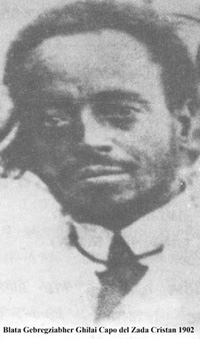
Gabra-Egziabher Gila Maryam was one of those a schola from the first generation who started the first Amharic newspaper in Addis Ababa by Gabra-Egziabher Gila Maryam an Eritrean who came to live in Addis Ababa in 1897. The newspaper had 15 copies, and it was written by hand as there was no printing press there source p.75
ብላታ ገብረ እግዚአብሔር ጊላይ ዝደረስዎም መጻሕፍቲ ተበለጽቲ ከም እተበለጹሎም ርኡይ ኪኸውን ከሎ፤ ብፍላይ (አእምሮ) እተባህለ ቀዳማይ ጋዜጣ ኢትዮጵያ መስሪቶም ብኢዶም እናጻሐፉ ኣብ ቀጽሪ ቤት መንግስቲ ሃጸይ ሚሊክ ይዝርግሑ ነበሩ። ብላታ ገብረ እግዚአብሔር ጊላይ ዝደረስዎም መጻሕፍቲ ተበለጽቲ ከም እተበለጹሎም ርኡይ ኪኸውን ከሎ፤ ብፍላይ (አእምሮ)
እተባህለ ቀዳማይ ጋዜጣ ኢትዮጵያ መስሪቶም ብኢዶም እናጻሐፉ ኣብ ቀጽሪ ቤት መንግስቲ ሃጸይ ሚሊክ ይዝርግሑ ነበሩ። እንተኾነ ግን ብቕንእን ካልእ ሻርነትን እተላዕሉ ጸላእቲ ከበብዎም። ሐንሳእ ሃይማኖት ዘይብሎም ኮተሊኽ ኢዩ። ሐንሳእ ከአ ከም ጸረ መንግስቲ ኢትዮጵያ እናአቕረቡ ከምርርዎም ስለ ዝጀመሩ፡ ዝርድኦም ሰብ እናወሓደ ከደ በብቕሩብ ከአ ስደት እናኸበዶም ብስጭት ከኣ እናገዘኦም ከደ`ሞ እቲ ዝዘርእዎ ዝነበሩ ፍርያም ዘርኢ ኣብ ከውሒ ከም እተዘርኤ እናበነነ ኣሳቐዮም። ብላታ ገብረእግዚአብሔር ሓያሎ መጻሕፍቲ ዝደረሱ ደራስን ጋዜተጤኛን ከም ዝነበሩ`ውን ብድሕሪኦም እተረቡ ጽሑፍቶምን ድርሰታቶምን ይምስክሩሎም።
ብላታ ገብረ እግዚአብሔር ጊላይ ብ1888 ብ1889ዓ.ም.ሓደጋዜጣኣስመራእተባህለጋዜጣፈጢሮም፡ብኢዶምእናጻሓፉይዝርግሑነበሩ።ጋዜጣኣስመራእቲቀዳማይብቋንቋሃገር፡ብወዲሃገርእናተጻሕፈእተዘርግሔጋዜጣኢዩ። ብላታ ገብረ እግዜአብሔር ኣብ ክንዲ ስሞም ዘዘውትሩዎም ናይ ብርዒ ስም እውን ነይሮዎም ኣብ`ቲ ጽሑፋቶም ከኣ ብላታ ገብረእግዜአብሔር ጊላይ መፍቀሬ ሃገሩ ሓማሴናይ እናበሉ ይፍርሙ ነበሩ። readmore
Sheikh Ahmad Umar Kuri
Sheikh Ahmad Umar Kuri the father of Sheikh Ibrahim Mukhtar in 1924 received advance religious education and was a specialist in Islamic legal sciences and director of the Islamic School in eastern Akkele Guzay

Sheikh Ibrahim Mukhtar Ahmed Omar was born in Eritrea in 1909 in a village close to the coast of the Red Sea. He was the second child in a family of seven siblings. His mother passed away when he was only ten years old. His father was a respected scholar who received his Islamic education locally as well as in Yemen and Hejaz (Saudi Arabia). Sheikh Ibrahim Mukhtar received his preliminary education from his learned father. Shortly after the death of his father, Sheikh Ibrahim Mukhtar, at the age of 15, left his village to go to Khartoum, in 1925 and studied in Omdurman before continuing on Cairo in 1926 to pururse an advance religious educatiothe capital of Sudan. In the Egyptian capital he studied in several Al-Azhar secondary institutes (1926-1931) before enrolling at Al-Azhar University.There, he was enrolled as a student in the Umdurman institute. After spending two years at the institute, he left Sudan for Cairo, Egypt where he was accepted as a student at Al-Azhar Al-Shareef University. He received the degree of Alyimia from Al-Azhar in 1937 then spent three more years in extensive study, specializing in the science of the Principles of Islamic Jurisprudence (Usul Al-Fiqh). Throughout his student life, he had the privilege of studying under the direction of more than ninety-three eminent scholars, many of whom belonged to diverse schools of thought and hailed from various parts of the world.
.Jonathan Miran also adds that Sheikh Ibrahim Mukhtar graduated from Al-Azhar University in 1937 with a specialization in Hanafi jurisprudence and worked in various capacities for Cairene published several article condeming the Italian fascist colonial regime in Eritrea. Confronted with dilemma of whether to go back to Eritrea, finally retured in 1940 after fifteen years abroad he was apponited in the same year by the Italian authorities as a president of High Sharai a court in Asmara. After receiving his Aliymia degree, Sheikh Ibrahim Mukhtar worked in different capacities. He worked as a teacher, a lawyer, and an editor with a publishing company. In Egypt he authored a number of books. He also reviewed, commented on, and published a number of classical books.
He also authored a number of anti-colonial articles in a newspaper known for its anti-colonial views. The Mufti spent about thirty years as a key figure in Eritrea where he served as a spiritual leader, an educator, an author, a jurist, and a conciliator.
Sheikh Ibrahim Mukhtar initiated and encouraged the establishment of schools. During his time, wealthy businessmen under his direction established many schools. He established the largest Islamic library in the country, donating more than 3,000 books from his own personal collection. source http://mukhtar.ca/biography/

Mr Bairu Uqbit was born in Gheremi. He had a great yearning for modern education early in his family, but in those days traditional Orthodx families did not permit their children to attend schools that were run by foreign missionaries. In the end his desire for education was such that he broke away from the influence of his family and joined the Swedish Evangelical Mission. At the mission school he acquire a working knowledge of Italian, Amharic, and Arithematic-that provided him with the platform to beome a self-taught person. Mr Bairu was a driving force in the struggle to eradicate illitracy; among the intellectual achievement of Mr Bairu, the translation of John Bunyan's " Piligrms Progress" in 1926, and his translation of the early New Testament in collaborarion with Embet Eksie, in 1934 Mr Bairu also translated several song in the Tigrinya Book of Hymns., Bairu Uqbit had also wanted to send his son Tedla to a teacher traning college in Florence [[Lundstrom, Karl John [314-315]
Semere T Habtemariam in his book review Herui Tedla Bairu’s Book wrote "Herui’s grandfather, one of the leaders of the Bible Readers’ Movement and an early translator of the Bible into Tigrinya, was an important voice. MFH and the many parties and organizations that came after it in the 1940s were primarily irredentist organizations and not nationalists. “The immediate objective of the founders of the MFH was to demand the abrogation of the apartheid laws of fascist Italy, to replace Italian administrators by Eritreans, and to end the colonial status of Eritrea in favor of some kind of association with Ethiopia."
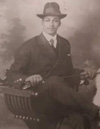
This was Deghiat Ghebray from Keyhkor and Sesah governor of Enganea Akle �
ደግያት ገብራይ ተኽሉ :- ብዓል ቀይሕ ኮርን ሰሳሕን ምስሌነ እንጋንአ አከለ ጉዛይ እብ ዓዲ ጥልያን ብ1910 አቢሉ
Btw,Dottore....this is him, probably in the circa1910s studying in Italy....He was one of the elites of his time. source https://www.facebook.com/samson.redeab?fref=photo
Wolde-Ab Wolde-Mariam 1905-1995

Wolde-Ab was born as Adi-Zarna, in Seraye, on 27 April 1905. His father sent him and most of his eight siblings to the Swedish Evangelical Mission (SEM) School in Mendefera, where Wold Ab excelled. He consequently attended the SEM seminary at Beleza from 1926-30. In 1931, Wolde Ab was assigned to teach at the SEM school in Suzana, among the Kunama people, where he remained until 1935, where he returned to Asmera to direct the SEM school system in Eritrea. During this period, Wolde-Ab worked to regularize and popularize the writing of Tigrinya. In 1932, he published the first Tigrinya grammar book, Fidel Tigrinya, followed by his Arki Temhera in 1942, both of which standard textbooks for the Eritrean school system through 1960. He remained director of SEM school until 1942, where the Britsh Adminstration enlisted him to direct and edit the Tigrinya-language newspaper Semenawi Gazetta, published weekly by the Britsh Information Service. Wolde Ab was already a leading Eritrean figure in the influential Protestant community, and the newspaper increased his political status. He was a founding member of the Mahber Feqri Hager but unlike most Protestants, Wolde-Ab hesitated to support calls for Eritrea's unification with Ethiopia. His fears of Ethiopian domination were confirmed when he visit Addis Ababa in 1943. Wolde Ab was dismayed by the corruption and poverty of Haile Selassie I status. He returned to Eritrea determined to find an alternative political future involving independence. Conell page 539
Excrept from WOLDEAB WOLDEMARIAM: A Biography of a Visionary Eritrean Patriot, by Dawit Mesfin
Wolde-Ab left his village of Adi Zarna at age 18 and joined the Swedish Mission School in Asmara. The teacher quickly learned Italian. He became proficient in the use of Italian both spoken and written. Eventually he entered the four-year Teacher Training Program in Beleza, the school run by Italian missionary teacher pastor Tron. After four years in the teachers training school Woldeab came out as a full-fledge teacher. It is hard to exaggerate the impact of Pastor Tron’s influence on Woldeab in terms of intellectual development and his immersion in Italian language and culture.
Woldeab as Teacher
He was assigned by SEM to teach in Asmara for a short period, after which he was assigned to teach in Kunama land, where he used the opportunity to study the Bible, tutored for three years by a Swedish woman missionary called Emebet Signe Berg until 1935 when she was expelled with the rest of Swedish missionaries by Italian fascist authorities. Signe Berg, a nurse by profession who had lived in Asmara, became Woldeab’s mentor and, over a period of three years, she taught him the Swedish language.
Woldeab’s insight into the empowering role of education was expressed by him in various circumstances, both as teachers as well as political activist and trade union leader. The author sums up Woldeab’s thinking about the role of education as follows:
“One can acquire a better understanding of Woldeab’s demeanor as a teacher and public educator by examining the wide-ranging books he used for class. He used a wide selection that dealt with world history, politics and sociology. Not only did Woldeab teach literacy, the Bible, languages, history and sociology, he also taught music to his students. Considering the state of Eritrea during the first half of the 20th century, the early stage of the establishment of education systems under various colonial governments, and a local structure opposed to change, one can argue that he did magnificently well.” (p. 57).
Woldeab expressed the impact of teaching on his life and work by saying: “ Being a journalist, even after leaving the teaching profession, also made me feel as if I was teaching .” In other words, once a teacher, always a teacher.
As in other fields, journalism was absent for Eritrean natives during the Italian colonial era, though there were Italian newspapers catering to the needs of the Italian community. These were specifically written to inform Italians about news of happenings in Eritrea and the rest of the world, and to spread colonial stories and disseminating Fascist propaganda. All this changed with the advent of the British upon the defeat of Italian occupation. By the end of 1942, the British introduced Eritrean Weekly News (EWN). Woldeab joined the editorial work in EWN and immediately set about the work of influencing national Eritrean sentiments, at first utilizing the formation of Mahber Fikri Hager (Patriotic Society) before it fell apart with division among the various protagonists. But that did not stop him from advancing his ideas using EWN (or Nai Eritra Semunawi Gazeta inTigrigna). As he continued writing articles and editorials in his magnificent Tigrigna, his fame and influence spread far and wide among Eritreans. The core ideas that Woldeab propagated incessantly in EWN were the importance of love, truth, honesty and his faith in God. This represented the manifestation in his journalistic role of the formative ideas and beliefs that he had imbibed in his evangelical church throughout his adult life. According to Dawit, Woldeab’s messages carrying Eritrean nationalist sentiments created tension between those who agreed with him and the others (perhaps the majority) who entertained “Ethiopian nationalist” sentiments.
Woldeab as Journalist and ‘Wordsmith’
Journalism and activism in politics are intimately connected. One is, or can be, the means for the other’s ends. Good politicians use journalism to communicate with people whose opinions matter, who can help in the attainment of aims. This is elementary and Woldeab instinctively knew it and used it effectively. His linguistic skills and effective use of folklore and apt proverbs and popular stories and anecdotes made him the best communicator of the times. Dawit Mesfin notes some of the problems facing Woldeab and his independence cohorts . He notes, for example that the EWN and in general the newspapers established by the British were conceivably intended “to provide a window for Eritreans to the outside world, to introduce foreign concepts such as self-determination and democracy in the country.” However, he observes that this happened at a time of growing economic distress, divisions among social groups and unrest. And he speculates that perhaps Eritrea was not ready for the “street politics” that EWN introduced. Woldeab himself later admitted that his own views as well as those of others were unclear regarding Eritrea’s future. Dawit contends that the views of Eritreans were “muddled” by the “sudden collapse of Italian rule, the institution of British rule, and systematic Ethiopian meddling in Eritrean affairs….”
In the context of this muddle, it is possible, Dawit argues, that Woldeab possibly thought he could help give clarity and influence Eritreans to adopt a unified approach. He seems to have thought that the newspapers that he edited and practically controlled (EWN, and later Hanti Eritra) would give him access to, and perhaps impact on, a much larger segment of Eritrean society than he could have influence previously. That Woldeab excelled in the use of Tigrigna is beyond question; he mobilised it and sent it to war for his ideas (to use Churchill’s use of English during World War II). The problem was that at the same time there were many who harboured different views about the future of the country who also took advantage of the newspapers, including EWN to advance their competing thoughts.
It is of great interest (and certainly of interest for historians) what the role of the British administration was in the context of the contention between those who sought Eritrea’s independence and those who fought for union with Ethiopia. Dawit hazards an opinion tentatively thus: “Perhaps the paper (EWN) was established to facilitate social and literary processes. Even if the British envisioned EWN would provide Eritreans with a voice and enable them to participate in their governance one of their main aims was to steer the locals towards supporting their administration…”Dawit continues his opinion in the same vein, “Although Woldeab was not allowed to stray into the overtly political and dialectical, he did not totally shy away from confronting the assumptions and premises of Eritrean society through his articles. He was driven by his instinct, insight and experience. ”
Woldeab’s use of his new-found medium was not limited to politics pure and simple. Donning his teacher’s hat, so to speak, he set out to teach his countrymen (and women!) of the importance of history, morality, truth, discipline and unity. He did this and more in spite of the restrictions that were imposed on him by the British. Dawit gives an example of an essay Woldeab wrote in 1942 about the differences between democracy and dictatorship in which he clearly delineated the power of the people. “by juxtaposing the universal values of democracy with the Eritrean way of life, he emphasized that Eritreans should be steadfast in their quest for democracy. In other words, he was expressing his concerns about Ethiopia’s intentions.”
With respect to Woldeab’s views about imperial Ethiopia, there are stories about what he said about its government after he visited Ethiopia and lived there for a year (1937-1938).In his remarks he was expressing his dedication to the democratic values and against the imperial (dictatorial) values. Obviously his views were not shared by the Eritreans who, at the time, were gung ho for Ethiopia–democracy be damned! And although he was vindicated in the long historical perspective, at the time and for almost half a century he was a tragic figure that suffered the slings and arrows of outrageous fortune. readmore
Woldeab Woldemariam ሓርበኛ ኣቦና ወልደኣብ ወልደማርያም
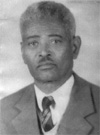
Yohannes Naffe’ was born in Musha in November 1912 and went to school in Gheleb under an Italian missionary, Maestro Coisson, whose family remained friends to Yohannes and family till the end. Yeba, who mostly preferred to talk in Tigre whenever possible, was at one time school director of the Evangelical School of Asmara. But for the rest of his life, he worked as constructor.
His family members recall that he built 33 churches of various denominations throughout Eritrea in addition to two major reservoirs, numerous water wells, schools and clinics. After liberation, he built, among other premises, the three-story Yohannes Hotel in Keren. Yeba fathered 10 children who include Lumumba Yohannes, a PhD holding engineer currently working with the USA Federal Aviation Administration and residing in Oklahoma. Other daughters and sons of Yohannes are graduates in journalism, economics, languages, accounting, nursing and other professions. Yohannes Naffe passed away on 27 February 2008 and buried in his birthplace. readmore
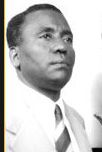
Tedla Bairu born on March 27, 1914. By the time he was five years old his father taught to read Tigrinya and Italian and to do Arthmetic. He attended the Swedish Evangelical Mission School in Asmera until 1926. In 1926 Mr Bairu sent his son to Italy, Mr Tedla studied to be a teacher at the "Instituto Magistrale Statale" in Firenze, Italy. He was one of the few Eritreans to study in Italy where he graduated from "Instituto Magistrale Statale in 1933. From 1934-1941 worked as a principal and teacher of Italian native school until 1940 in different part of Eritrea, ending this career in Adwa, where he was employed by the British Adminstration as an interpreter in 1941. He served as a translator in the Asmara Native Affairs Office of the BA until 1946, and was the first director of the Semenawi Gazetta . Tedla was not in Asmara when Mahber Feqri Hager was founded in May 1941 but he became involved in the organization upon his returen to Eritrea, He left the BA in late 1946 at the Wala Bet Gherghis in November, he led the unionist wing of the NFH in rejecting Wolde Ab's proposed compromise
Tedla was also active with the church choir as an organist and conductor. Mr Tedla has also contributed to the compilation of Tigrinya book of hymns ;Lundstrom, Karl John [2011 p316 kenysha] ; Conell p493. read more
Sheikh Abdulkader Kebire(1902 - 1949 )

Abdulkadir Kebire was born in the Massawa area in 1902 though some stories indicate he was actually born in his mother’s village in the Dankalia region. As a child, Kebire attended Khelwa where he studied the Quran and Arabic. Later on he attended primary school and finished grade four, the highest education Eritreans were allowed to arrain under the Italian occupation. But Kebire never stopped pursuing knowledge on his own and he was mainly self-educated though he benefited from the knowledge passed to him from the elders of his family and his exposure to the rich library that his family possessed.
At the age of 18 Kebire traveled to Egypt where he witnessed the revolution of Saad Zeqlul against the British occupation, an incident that left its mark on him and shaped his rebellious character. Soon he became more interested in politics and was determined to make a change in his country and to improve the livelihood of his people. readmore
Blaten Geta Lorenzo Taezaz (June 1900 - June 1946)
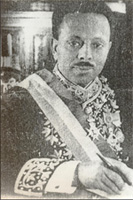
Lorenzo Taezaz was born on 30 June 1900 in the Akele Guzaie province of Eritrea, then an Italian colony Because of his intelligence and hard work, Lorenzo rose to the rank of Secretary to the Governor of Asmara, the highest position that an Eritrean could reach in the colonial administration.
In 1924, while on vacation in Aden, he met Ras Teferi Mekonnen, the future Haile Selassie, who was there on an official visit, and who encouraged him to go to Ethiopia. A year later, Lorenzo went to Addis Ababa. Subsequently, Ras Teferi Mekonnen arranged for his education, and along with other Ethiopians, he sent him to France on a government scholarship. Lorenzo spent the next eight years at the University of Montpelier where he completed his studies in Law and Philosophy. Apart from his native Tigrigna, he already spoke Amharic, Arabic and Italian, but Montpelier also provided him with an opportunity to master French and English.
He returned to Ethiopia in 1933 and began to serve the Ethiopian government in several capacities: Secretary, Ministry of Justice (1933); member of the Anglo-Ethiopian Boundary Commission which demarcated Ethiopia’s borders with former British Somaliland (1933-34); member of the same Commission which was charged with the duty of surveying the grazing grounds of the Ogaden, and investigating the causes of the Wal-Wal incident of 1934, which led to the Italo-Ethiopian War of 1935-1941; appointed private secretary of Haile Selassie, and in addition he served as liaison officer to the international press (1935-1936). He even saw action at the Battle of Maichew (1936) that culminated in the defeat of the Ethiopians by the Italians. source bahrenegash.com/ [readmore]
Memhir Yishak Teweldemed(1889-1978)
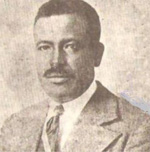
Source History - Isahac Teweldemedhin by Sennay Ghebreab
Isahac Teweldemedhin was born on August 27th 1889 In Ghelab, a small village in Eritrea. His father was Pastor Teweldemedhin Ghebremedhin, who studied Theology in Sweden in 1887 and who was one of the founders of the Evangelical Churches in Eritrea. His Mother, Ametu, was the daughter of Pastor Zeratsion also a Protestant theologist. He was the oldest of a family of six, with one brother and two sisters. His brother Ephrem Teweldemedhin was a Civil servant and diplomat under the regime of Emperor Haile Sellassie Ist of Ethiopia.
Isahac was educated at the schools of the Swedish Evangelical Missions (SEM) in Gheleb and Asmara. In 1913, he continued his higher education at the American University in Beiruth and later in Florence, Italy.
Coming back to Eritrea from his studies abroad, he started teaching at the Swedish Evangelical Mission schools in Eritrea until the colonial government of Italy, shut down all SEM schools. At this time, Isahac moved to a small town called Merara and to earn his living he bought a piece of land and became an entrepreneur. This was during World War II.
In post War Eritrea, during the British Occupation, Major Kinneston Snell became the Head of Education in Eritrea. After hearing about Isahac’s competency as one of the foremost educated Eritrean he went to Merara to meet and ask Isahac’s assistance to reorganize the educational system in Eritrea. Isahac then returned to Asmara and while teaching, and writing issues related to pedagogy in the Tigrigna (Eritrean) language he also played a major roll in recruiting and training elementary school teachers in Eritrea with heart and soul.
Isahac began writing articles, sayings, stories etc., and in 1944, he was one of the team who set up a symposium with the purpose of discussing the standardization of the writing and pronunciation of Tigrigna letters and words. During that year he also published the first book of arithmetic in Tigrigna, when he became the first Eritrean innovator in the field of abbreviations, equivalents of weights, measures and also the standardization of punctuation marks in Tigrigna.
Isahac initiated and promoted the first Girls’ school in Asmara in 1944, Eritrea as well as in some other villages. He was also one of the active members in the establishment of Middle School in Asmara.
In the 1950’s, after Major Snell, left Eritrea, Isahac became the Head of Education in Eritrea, and he worked with heart and soul to promote education even to the remote villages of Eritrea.
In the Eritrean history, Isahac was a famous publicist, teacher and educator and a person full of educative humor. Isahac was also an active member of the Evangelical Church in Asmara.
Isahac Teweldemedhin passed away on July 8th 1978 in Asmara. “Isahac Teweldemedhin Secondary School” in Asmara is named after him.
References:
Rosa Holmer, “Isahac Teweldemedhin: Nagra Bilder Ur Hans Handelserika Liv”, 1938.
Isahac Teweldemedhin , “A Short Reader in Tigrinja– Forty-four Stories”, Asmara 1943
Isahac Teweldemedhin, “Beginner’s Arithmetic in Tigrinja”, Asmara 1944
Yishak Yoseph, “A Short Biography of the Teacher Isahac Teweldemedhin: War on Illiteracy”, Asmara 1986
Encyclopaedia Aethiopica, Vol. 5, hrsg. von A. Bausi und S. Uhlig, Wiesbaden: Harrassowitz 2014, 63-64.
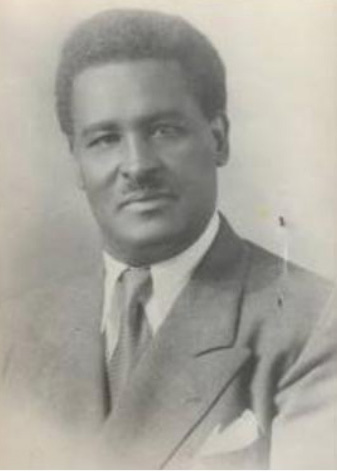
In 1923 Ephreme Tewolde Medhin, the teacher who had been serving at schools in Beleza and Asmara, left for Addis Ababs to serve under the Ras Tefri " May God bless his work" was the note of farewell [p294]
When Daniel Kinde visited the late Ambassador Ephreim Tewolde Medhin at his residence in Asmara, he was ninety years of age. The following is a summary of what I was able to gather from him: Ambassador Ephreim Tewolde Medhin Lorenzo was my life long friend. Ever since we left Eritrea, we shared adversity and happiness together. There was no future for both of us in Eritrea. In 1925 we escaped to Aden. It should be recalled that Lorenzo had met Ras Teferi Mekonnen in Aden a year earlier and had thus invited him to go to Addis Ababa. I took the boat and waited for him in Djibouti. When we met in Djibouti, both of us were in tears. From there, we took the train and went to Addis Ababa. Ras Teferi Mekonnen asked us what we wanted to do. Both of us requested him to send us abroad to school, which he did. I went to Beirut. Lorenzo went to France... What we did for Ethiopia during the war, is for history to judge. We stayed in Europe to help intensify the diplomatic struggle, but Lorenzo was exceptional. He even traveled inside Italian occupied Ethiopia on secret missions. I can assure you that he was a selfless patriot. At a time when an entire generation of educated Ethiopians was simply wiped out by fascism, he was Ethiopia’s eyes and ears. The British only talked to him.(4)source http://emnetu.com/
Blata Mohammed Omer Qadi 1909
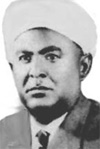
Blata Mohammed was born in 1909 in Foro, to an enlightened religious family. He lived most of his adult life in Massawa where from an early age; he gained prominence and respect for his soft spoken and reconciling attitude. Blatta Mohammed was one of the earliest Eritrean intellectuals who left his mark in Eritrean political history. Fluent in both Italian and Arabic, on top of Tigrigna, Tigre and Saho, Blatta Mohammed was a widely read prolific writer. He was the publisher of the weekly Arabic Newspaper, Sawt Eritrea, the mouthpiece of the Moslem League from 1943 until its closure by executive orders in 19 54. Later, in 1952, the beginning of the federation period, he became the director of the Italian Newspaper, Union e Progresso. Blatta Mohammed was one of the important and hard working nationalist politicians of his time. source emnetu.comReadmore
Issayas Gebre Igziabiher: - (Lt. General Issayas Gebre Igziabiher) Graduating from Swedish Mission School and went to Ethiopia in the late 1920s to pursue his education. In the early 1930s Emperor Haile Sellasie had opened the Holeta Military Academy where Issayas became a student. When the Italians invaded Ethiopia and Haile Sellasie went into exile, Issayas stayed in the country and distinguished himself as anti-Italian guerrilla leader. Upon Haile Sellasie’ return, Issayas became a high-ranking officer in the Ethiopian armed forces.
Samuel Ghebreyesus born 1908 in Hamasien. Educated at Swedish Mission School, Asmara, in Addis Ababa at the American Mission in Japan and at the Lutheran School, Madras. Returned to Ethiopia in 1936; captured by the Italians on suspicion of being involved in Graziani bomb incident and sent to Italy where he was imprisoned for seven years. Released by British in 1943 and returned to Ethiopia. Employed in various ministries, including Ministry for Foreign Affairs. Came to Asmara August 1948 as secretary to Colonel Negga. Speaks fluent English.
General Goitom Ghebrezgh 1925-2009

Goitom Ghebrezghi was born in 1925 in the village of Mefalso, near Mendefera, the provincial capital of Seraye in western Eritrea. He was the fourth child in a family of eight children. He also had roots in Adi Baro, Tsilima, where his father’s line was from.
Also known as Wedi Ma’ke, Goitom Ghebrezghi had a modest upbringing and was self-taught, with no formal education. But he had a sharp mind and was fluent in five languages: Tigrigna, English, Italian, Arabic and Amharic. In his early years he taught English in Asmara part-time. He was also a fine footballer and tennis player in his youth.
He was distinguished by his decency and goodness in bringing people together, even at his own expense. He had love not only for his own family, but for all.
General Goitom is survived by five sons and a daughter.
General Goitom Ghebrezghi, Chief of the Eritrean Police Force and Eritrean expatriate community leader in the US, was born on May 12, 1925. He died on March 3, 2009, aged 83
Read moreCapt. Ahmed Sheik Feres 1927-2010

Ahmed Sheik Feres was born in 1927 in Hergigo. He worked as a sailor and as vice captain on various Italian, Italian-Eritrean, Greek, Ethiopian and Saudi commercial vessels in the 1950s and 60s. He studied in Italy in commerical marine navigation and seamanship readmore

Fessehtsion Beyene was born in Keren, Eritrea in 1890.
•He spoke Tigre, Tigrigna, Arabic, Italian and Amharic.
•He moved to Asmara after working as a cook in Keren.
•In Asmara he became a driver for an Italian official in the early 1920’s. It is believed that there were only 4 or 5 Eritreans who had driving licenses at that time.
•In 1921, Fessehatsion went to Italy as a driver for the Montenero family.
•He went back to Eritrea on December 1923 (it is not clear if this was by choice or a necessity imposed on him).
•His son, Claudio, the product of a relationship with an Italian woman, was born in March 1924. One could imagine the scandal that ensued from public knowledge about this union.
•Fesshatsion went back to Italy in 1927 as a translator for Yemeni army pilot-trainees. This aviation connection was unclear to me until my good friend, Dr. Massimo Zaccaria , explained to me that it was the new policy of Jacopo Gasparini, the Italian governor of Eritrea of the time, who masterminded a regional policy based on good relations with Yemen, hence, the presence of the army-pilot trainees in Italy.
•In 1928, Fessehatsion obtained his pilot’s license.
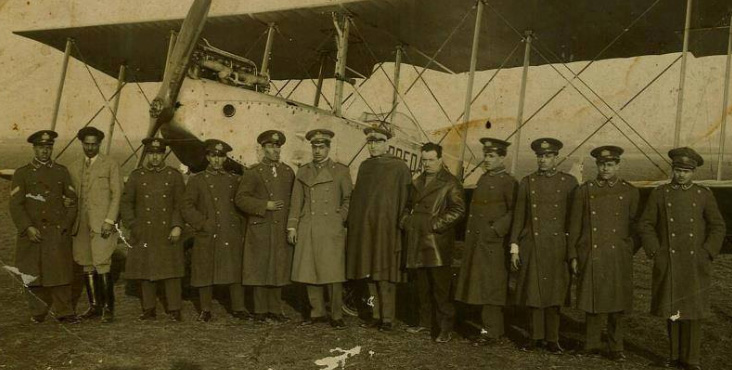
1928? Second From Left Capt Fissehazion the first Eritrean Pilot Before 97 Years Second from Left
Jacopo Gasparini, the Italian governor of Eritrea (1923-1928)
From the book “Italian Colonialism in Eritrea” by Zemhret Yohannes in Tigrigna.
•In 1929 he was sent to Somalia (though not as a pilot, but rather as a foot soldier) and remained there until 1936. By this time his son Claudio was 12 and, by virtue of his mother, an Italian citizen. Fessehatsion in the meantime had also married a Somalian lady in Somalia and had two sons with her.
•In 1937, he managed to have his son Claudio with him in Somalia, though he could not acknowledge him as his son (a colonial ‘subject’ could not acknowledge an Italian citizen). Fessehatsion was able to obtain residency for his son, but at the same time Fessehatsion was forbidden to go back to Italy forever. This seemed to be due to the embarrassment the Fascist government had in dealing with the fact of a black man having a son with an Italian lady. In fact, the military records of Fessehatsion do not mention any misdeed and, on the contrary, kept stressing his unusual skills, cleverness, etc. At a certain point, official records became silent on the fate of the two. But it seems that the colonial administration found it unacceptable for an Italian citizen (Claudio Ricucci) to live together, in a father-son relation, with an African man. This would explain why Claudio ended up in a boarding school, whose costs were paid for by Fessehastion.
•He was kicked out of Somalia and settled in southern Ethiopia where he died in the early 1960’s. readmore
Fitewerari Fisehazion was born and raised in Keren. Many of his family members live in Keren and the diaspora.He was a true symobol and historic figure to succed as eritrean and Black African to confront colonial racism to be first Black pilot .Yohannes Ferdinando Drar
I PRIMI PILOTI AL MONDO DELL'AFRICA ERANO ERITREI. from Pasquale Santoro's facebook
Sino a qualche tempo fa sapevamo che il primo pilota militare eritreo è stato Mondelli che nasce ad Asmara (Eritrea) nel 1886. Il suo vero nome è Wolde Selassie.Ottine il brevetto da pilota nel 1914.
Dopo una straordinaria carriera da leggenda, nel 1970 diventa Generale di Corpo d'Armata.(nella seconda foto)
Tuttavia abbiamo un altro eritreo che merita menzione
Si tratta di Fessehtsion Beyene è nato a Keren, Eritrea nel 1890. Parlava il Tigre, Tigrigna, arabo, italiano e amarico. Si trasferisce a Asmara dopo aver lavorato come cuoco a Keren.
In Asmara faceva l’autista per un funzionario italiano nei primi anni del 1920. All’epoca esistevano solo 4 o 5 eritrei che avevano patenti di guida
. Nel 1921, Fessehatsion andò in Italia come un autista per la famiglia Montenero. Tornò in Eritrea il dicembre 1923 . Suo figlio, Claudio, il prodotto di una relazione con una donna italiana, nasce nel marzo 1924. Si può immaginare lo scandalo che ne seguì su questa unione.
Fesshatsion ritornò in Italia nel 1927 come traduttore per piloti tirocinanti yemenitii.
Questa opportunità gli fu data dal Governatore dell’Eritrea dell’epoca, Jacopo Gasparini, che, passa alla storia ,oltre che per aver fondato Tessenei,per l'aver tentato un colpaccio che avrebbe reso l'avventura in Eritrea ben diversa: acquistare un protettorato sullo Yemen. Gli inglesi, ovviamente riuscirono ad ostruire l'operazione, ma il peggio lo compì Mussolini, che tergiversò e si lasciò sfuggire il controllo di un'interessante area petrolifera.
Per lui , quindi, la presenza dei piloti yemeniti in Italia che erano stati invitati per voli di addestramento, fu l’occasione per inserire Fesshatsion nei loro ranghi.
. Nel 1928, Fessehatsion ottiene il brevetto di pilota diventando, di fatto, il secondo pilota di tutta l’Africa di nazionalità eritrea. , come il Generale Nero ed eroe Wolde Selassie. Translation
http://www.ethiotube.net/video/11283/esat-history-the-untold-story-of-negadras-gebrehiwot-baykedagn-%E1%8B%A8%E1%8A%90%E1%8C%8B%E1%8B%B5%E1%88%AB%E1%88%B5-%E1%8C%88%E1%89%A5%E1%88%A8%E1%88%85%E1%8B%AD%E1%8B%88%E1%89%B5-%E1%89%A3%E1%8B%AD%E1%8A%A8%E1%8B%B3%E1%8A%9D-%E1%89%B3%E1%88%AA%E1%8A%AD
It was in these circumstances that Gabra-Hewat fled with some other companions to Eritrea at the age of seven. According to Richard Caulk, Gabra-Hewat joined the
Swedish mission school at Menkullu, on the mainland off Massawa. A trip to the port of Massawa that he subsequently made with his friends was to change decisively the course of his life. Gabra-Hewat and his friends got permission from the captain of a German ship source
Hajj Hummed Ibrahim Neberai 1914-1982
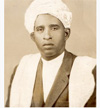
Hajj Hummed Ibrahim Neberai was born in 1914 to a prominent family of the Blin of Keren and died in 1982 in his birth town. He completed the rudimentary elementary education that was available in Keren during the middle part of the Italian colonial period. He continued to teach himself, exploiting every opportunity that availed throughout his life. He was a fluent speaker of Arabic, Italian, English, Tigrinya, Blina and Tigre, and, read and wrote primarily in Arabic and Italian.
Hajj Hummed was one of the first local entrepreneurs of Eritrea to engage in the export of peanuts (groundnuts) to Europe in commercial quantities. He was also a founding investor of the first and most successful Gum Arabica export company of the region, the Eritrean Gum Arabica Company (شركة اللبان الإرترية) of which he was the CEO until he died. Hajj Hummed was a founding member of the Islamic endowment of Keren (أوقاف) and its only local donor of commercial real estate. Hajj Hummed was also a founding member of Keren city’s oldest Islamic School (معهد الدين الإسلامي في كرن).
Hajj Hummed was a kindhearted philanthropist and a devout family man. He was kind and attentive to the young and the old, generous with his money and sage advice. Many a Kerenite, Christian and Muslim, old and young, has benefited from Hajj Hummed’s generosity, encouragement and advice. Above all, though, he was known for his devotion to education, especially his unwavering advocacy of the unrestricted right of Muslim girls to education at a time when this was far from the prevailing social norm source http://www.neberai.com/home/
Further information Kamal M Ibrahim comment on FB. Hummed Neberay is older brother of Dr Yousif Neberai who also graduated from the American University Beirut, had a long career in the ministry of education, obtained Ph D from UNM in the US and was faculty of the universities of Khartoum and Al-Ain (UAE). I believe there was a time period when the two Neberais served at the MoE in Asmara at the same time
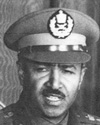
Aman Mikael Andom (21 June 1924 – 23 November 1974) was the first post-imperial acting Head of State of Ethiopia. He was an Eritrean originally from the village of Tsazega in Hamassien province of Eritrea. He was appointed to this position following the coup d'état that deposed Emperor Haile Selassie on 12 September 1974, and served until his death in a shootout with his former supporters. His official title was Chairman of the Provisional Military Administrative Council (better known as the Derg), and he held the position of Head of State in an acting capacity as the military regime had officially proclaimed Crown Prince Asfaw Wossen as "King-designate" (an act that would later be rescinded by the Derg, and which was never accepted by the Prince as legitimate).
As commander of the Third Division, General Aman had been beating back the encroachments of the Somali army on the eastern border with a zeal and success that he was known as the "Desert Lion." However, in 1964 the Emperor dismissed General Aman Andom when he began to attack into Somalia in violation of an order from the Emperor, and Aman afterwards served in the Ethiopian Senate in a "political exile". There is some evidence that indicates he had contacts with the officers of the junta as early as February and March 1974, but by July he was appointed chief of staff to the military junta. Three days after the junta removed the Emperor from his palace to imprisonment at the headquarters of the Fourth Division, this group appointed him their chairman and president of Ethiopia. At the same time, this group of soldiers assumed the name "Provisional Military Administrative Council", better known as the Derg.[1]
From the first day of his presidency, the Ottaways note, "the general found himself at odds with a majority of the Derg's members over most major issues, including whether he was 'chairman' of the ruling military body or simply its 'spokesman.'"[2] Aman fought the majority of the Derg over four central issues: the size of the Derg, which he felt was too large and unwieldy; the policy to be taken towards the Eritrean Liberation Front (ELF); and over the punishment of the numerous aristocrats and former government officials in the Derg's custody. Moreover, the Derg wanted the army from Harer to move to Eritrea and the army that was in Eritrea to move to Harer. He said, if they army from Hare move to Eritrea, they will be too brutal to the people. The Derg said the army in Eritrea will not fight because they were too integrated with the people. His refusal to sanction the execution of former high officials, including two former prime ministers and several royal family members and relatives, put his relations with the majority of the Derg on an especially bitter footing.
As an Eritrean, General Aman found himself fiercely at odds with the majority of the Derg. He wanted to negotiate a peaceful settlement; his opponents hoped to crush the ELF by military force. Aman went as far as making two personal visits to Eritrea—the first 25 August to 6 September, the second in November—giving speeches stating that the end of the Imperial regime was also the end of old practices towards Eritrea, that a government dedicated to national unity and progress would restore peace and prosperity to Eritrea, and lastly that he would begin investigations concerning crimes that the army had perpetrated on Eritreans and punish the guilty.[3]
However, at the same time the Derg had begun the task of eliminating opponents within the military. The three significant units were the Imperial Bodyguard, the Air Force, and the Corp of Engineers; of the three, the most recalcitrant were the Engineers. So on 7 October soldiers loyal to the Derg stormed the Engineers' camp, killing five, wounding several and detaining the rest. As Bahru Zewde observes, "With that, the illusion that the revolution would remain bloodless was exploded."[4]
General Aman responded with a personal campaign to seek support outside the Derg, amongst the rest of the army and the country where he was popular. On 15 November he sent a message to all military units that was highly critical of the Derg. During a general assembly of the Derg two days later, Mengistu Haile Mariam demanded that 5,000 men be dispatched to Eritrea and six imprisoned Imperial officials be executed; Aman Andom refused, resigned his official posts and retired to his house where he secretly sent appeals to his supporters, especially those in the Third Division. But Mengistu managed to intercept these appeals.[5]
General Aman died in a battle with troops sent to his home to arrest him. The actual cause of his death remains unclear, whether he was killed or committed suicide. That same night, the political prisoners that the Derg had marked for execution were taken from Menelik prison, where they had been held, to the Akaki Central Prison where they were executed and buried in a mass grave.[6] “It appears that the general had outlived his usefulness,” Bahru Zewde concludes, “and was in fact becoming an obstacle to the Derg’s exercise of power.”[7]Source: wikipedia

ቅድሚ 55 ዓመት ልክዕ ከምዛ መዓልቲ እዚኣ ቀዳም ምሸት 21 ለካቲት 1964 ምክትል ከንቲባ (ኣመሓዳሪ) ከተማ ኣስመራ ደጃዝማች ሓሰን ዓሊ ዓሪፎም። ብምሸቱ ከኣ ዜና ዕረፍቶም ናብ ከተማ ኣስመራን ናብ ኩሉ ወገናት ኤርትራን ምስ ተነግረ ብትግሃቶምን ሕያውነቶምን ኩሉ ፈታዊኦም ኣልቀሰሎም። ከምቲ ዝተመደበ ፍርቂ መዓልቲ ሰንበት ስነ-ስርዓተ ቀብሮም ኣብ ዝተፈጸመሉ ኣጋጣሚ ከኣ ካብ ኩሉ ወገናት ኤርትራን ከተማ ኣስመራን ማእለያ ዘይብሉ ቀባራይ ላዕለዎት ሰበስልጣን ኣብ ዝተኻፈልሉ ተፈጸመ። ሬስኦም ካብ ቤቶም ብበተሰቦምን ፈተውቶምን ተሰንዩ ናብ መቕብር ክሳብ ዝበጽሕ ሙዚቀኛታት ምምሕዳር ከተማ ኣስመራ በብዓይነቱ ናይ ሓዘን ሙዚቃ እናዘየሙ ብክብ ዝበለ ስነስርዓት ዓጀብዎም። ኣብ ቀብሮም ካብ ዝተኻፈለ ብዙሕ ህዝብን መራሕትን ድማ፡ ፊተውራሪ ተስፋሃንስ በርሀ ናይ ኤርትራ ጠቕላይ ግዝኣት ምክትል እንደራሴ፡ ከንቲባ ሓረጎት ኣባይ ናይ ከተማ ኣስመራ ከንቲባ፡ ፊተውራሪ ዓሊ ሙሳ ረድኣይ፡ ደጃዝማች ሓምድ ፈረጅ ሓምድ፡ ብሪጋደር ጀነራል ዘርአማርያም ኣዛዚ፡ ዳይረክተራትን ኣውራጃ ገዛእትን መኮንናትን ነበሩ።
ደጃዝማች ሓሰን ዓሊ ብ1878 ኣብ ዓዲ ሓንሶም (መራጉዝ ሰራየ) ተወለዱ። ብንእሽትኦም ከለዉ ድማ ኣብ ዓዶም ናይ ቁርኣን ትምህርቲ ብትግሃት ተማሃሩ። ካብ ንእስነቶም ጀሚሮም ናይ ትምህርቲ ጥቕሚ ኣጸቢቖም ዘስተዕሉን ዝርድኡን ስለዝነበሩ ድማ ካብ ዓዶም ናብ ኣስመራ መጺኦም ትምህርቲ ጀመሩ። ኣብ 1897 ኣብ ጶስጣ ስራሕ ጀሚሮም። ምሸታዊ እናተማህሩ ድማ ቋንቋታት ትግርኛ፡ ኣምሓርኛ፡ ጣልያንኛን ዓረብኛን ኣጠናቒቖም ክመሃሩን ክመልኩን ከኣሉ። ብዘይካ’ዚ ጽቡቕ ዝኾነ ምልከት ናይ ቋንቋ ትግረ’ውን ነበሮም። ንትምህርቶም ዝበቅዕ ኮይኑ ብዝተረኽበ ከኣ ኣብ ምጽዋዕ (1907-1908) ከም ተርጓማይ ተቖጺሮም ኣብ ኣውራጃ ግዝኣት ብህዝብን ሓለፍቶምን እተመስገነ፡ ትግሃትን ክእለትን ዝመልኦ ኣገልግሎት ፈጸሙ።
ብ1908 ድማ ካብ ምጽዋዕ ናብ ዋና መደበር ምምሕዳር ኣብ ኣስመራ ተቐየሩ። ካብ 1932-1937 ኣብ ዝነበረ እዋን ብመሪሕነት ኣብ ጨንፈር ሲቪላውን ፖለቲካውን ጉዳያት ሰርሑ። ብድሕር’ዚ ካብ 1939 ክሳብ 1953 ኣብ ዘሎ ግዜ ናይ ካልኣይ ክፍሊ ኣስመራ ምስሌነ ተሸሙ። ካብ 1953 ክሳብ 1956 ድማ ኣመሓዳሪ ወረዳ ከተማ ኣስመራ ተሸይሞም ከምሓድሩ ድሕሪ ምጽናሕ ካብ ወርሒ ሓምለ 1956 ክሳብ እዋን ዕረፍቶም ናይ ከተማ ኣስመራ ምክትል ከንቲባ ተሸይሞም ብእምነት ኣገልግሎቶም ፈጸሙ ።
ዝኸበሩ ደጃዝማች ሓሰን ዓሊ ብዘይካ ኣብ ውሽጢ ሃገሮም በብግዜኡ ናብ ዓዲ ጥልያን (1938 &1940) ፡ ሕጃዝ የመን፡ ስዑዲ ዓረብያ እናኸዱ ክርእዩን ክዕዘቡን ስለዝኸኣሉ ዓቢ ናይ ምምሕዳር ፍልጠትን ልምድን ክድልቡ ክኢሎም እዮም። ካብቲ ኣብ ወጻኢ ዘገልገልዎ ክዝከር ከሎ፡ ኣብ ኮሚሽን ምምልካት ዶብ ኣብ መንጎ ናይ ኢጣልያ ሶማሊላንድን ኢትዮጵያን (1910-1911) ከም ተርጓማይ ኣገልገሉ። ከምኡ’ውን ኣብ ቆንስል ኢጣልያ ኣብ ሑደይዳ የመንን(1911-1913)፡ ኣብ ጅዳ ስዑዲ ዓረብያን (1917) ከም ተርጓማይ ሰርሑ። ኣብ 1926 ብጀይ ጋስፓሪኒ ተመሪሑ ምሕዝነታውን ንግዳውን ስምምዕ ኣብ መንጎ ጥልያንን የመንን ንምክያድ ምስ ዝኸደ ልኡኽ ጉጅለ ተሳቲፎም ነይሮም። ብ1929 ብሰይፍ ኣልኢስላም መሓመድ ናይ የመን ዝተመርሐ ኮሚተ ኣሰንዮም ንዑደት ናብ ንጉስ ጥልያን ናብ ሮማ ከይዶም ነበሩ። ብተወሳኺ ኣብ 1932 ኣባል ናብ ኣሲር ናይ ዝተላእከ ልኡኽ ነበሩ። ከምኡ’ውን ደጃዝማች ሓሰን ብ1913 ኣብ ሕጃዝ የመን ናይ ቆንስል ጸሓፊ
ኮይኖም ኣገልገሉ። ኣብዚ ግዜ’ዚ ኣብ ናይ ትርጉም ስርሖም ስለ እተመስገኑን እተናእዱን ንጉስ ሑሴን ናይ ሕጃዝ ክብ ዝበለ (ኮማንደር ናይ ስርዓት ሃሺማይት) ንሻን ሸለምዎም (1922) ።
ብ1962 ከኣ ግርማዊ ንጉስ ነገስት ቀደማዊ ሃይለስላሰ ብዝፈጸምዎ ኣገልግሎት ናይ ኢትዮጵያ ናይ ክብሪ ኮኾብ ኣዛዥ መኮንን (ኮማንደር) ኒሻን ሸለምዎም። ኣብ ርእስ’ዚ ኣብ 1936 ናይ ደጃዝማች መዓርጎም ክወሃቡ ከለዉ ኣብ 1939 ድማ ናይ ጥልያን ኮማንደር ኮኾብ ክስለሙ በቒዖም እዮም።
ደጃዝማች ሓሰን ዓሊ ብ1941 ሓደ ካብቶም መስረትቲ ‘ማሕበር ፍቕሪ ሃገር’ ነበሩ። ድሕሪ ምፍሻል ዋዕላ ቤት ገርግሽ ኣብ 1946 ድማ ሓደ ካብቶም መስረትትን ዓበይቲ ምሁራት መራሕትን ናይታ ንናጽነት ኤርትራ ትጽውዕ ዝነበረት ሙስሊም ሊግ ነበሩ። ብተወሳኺ ነቲ ኣብቲ ግዜ’ቲ ኣብ ካይሮ ዝነበረ ሸኽ ኢብራሂም ኣልሙኽታር ናብ ኤርትራ ተመሊሱ ብጣልያን ብታሕሳስ 1939 ዝተዋህቦ ናይ ጠቕላሊ ሙፍቲ ቦታ ክሕዝ ኣብ ምእማኑ ኣገዳሲ ተራ ተጻዊቶም እዮም። በዚ ምኽንያት ድማ ሙፍቲ ኢብራሂም ኣልሙኽታር ድሕሪ ናይ 15 ዓመታት ስደት ናብ ሃገሩ ብሚያዝያ 1940 ተመሊሱ ሃይማኖታዊ መንገዲ ሕብረተሰቡ ኣብ ምስትኽኻል ኣበርከተ።
ደጃዝማች ሓሰን ዓሊ ከም ዓቢ ንናጽነት ኤርትራ ዝድግፉ መራሒ መጠን ንምእላዮም ብማሕበር ኣንድነት ኣብ ታርጌት ኣትዮም እዮም። ከም ሳዕቤኑ ድማ ኣንድነታውያን ክልተ ግዜ ማለት ሓደ ኣብ ሓምለ ሓደ’ውን ኣብ መስከረም 1947 ንምቕታሎም ኣብ ገዝኦም ተተኳሲ ብምድርባይ ፈተነታት ኣካዪዶም ነበሩ። እንተኾነ ግን ደሓኑ።
ኣብ መመረቕታ ቀዳመይቲ ሕታም ጋዜጣ ሙስሊም ሊግ ”ሰውት ኣልራቢጣ ኣልኢስላምያ” ኣብ ለካቲት 1947 ደጃዝማች ሓሰን ዓሊ ኣብ ዝጸሓፍዋ ጽሕፍቲ ከምዚ ይብሉ፡ “እዛ ጋዜጣ ብዘይካ ምህናጽ ምሕዝነት ምስ ኣብ ምሉእ ዓለም ዝርከቡ ኣስላም ንምሕያል ክልተኣዊ መረዳእታ ኣብ መንጎ እቶም ብሃገራዊ ረብሓታትን ብቁጠባውን ማሕበራውን ሓላፍነታት ምሳና ዝተኣሳሰሩ ኣሕዋትና ክርስያን’ውን ከተገልግል እያ።”
ደጃዝማች ሓሰን ዓሊ ምስ ዓብን ንእሽቶን እናተሰማምዑ ትግሃትን ሕያውነትን ናይ ምምሕዳር ብስለትን እናርኣዩ ኣብ ዝተፈላለዩ ምሕደራውን ዲፕሎማስያውን ጽፍሕታት ብዘይ ምቁራጽ ን67 ዓመት ድሕሪ ምግልጋሎም ኣብ መበል 86 ዓመቶም ብሰላም ዓረፉ።
ምንጪ፡
ጋዜጣ ሕብረት 1964
Chi e? dell’ Eritrea, 1952:
dizionario biografico,
con una cronologia by Puglisi, Giuseppe
Paths toward the Nation: Islamic Identity, the Eritrean Muslim League and Nationalist
Mobilization, 1941-61 by JOSEPH L. VENOSA
source Anxar Amex Niqales facebook
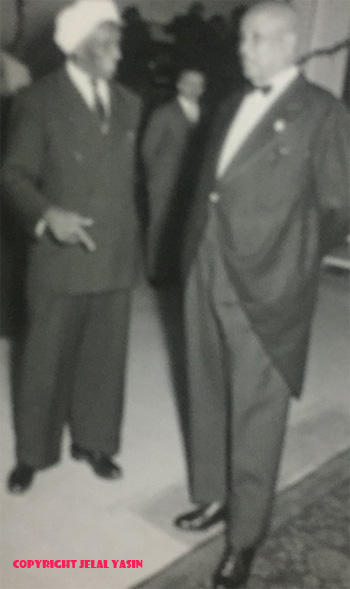
Deghiat Hagos Ghebre the first Mayor and Deghiat Hassen Ali the first v/Mayor of Asmara city 1950s
https:// hedgait.blogspot.com/2019/ 02/ dej-hassen-ali-1883-1964-sh ort-biography.html
Deghiat Hagos Ghebre born in Keren 1896 from a family descended from the Kentiba of Milezanay (Shioatte Anseba).
He completed his elementary school education at Asmara governmental school.
He was married to Lettehaimanot Nuguse, and they had two children.
1911 - He was Hired by the government of Eritrea and was appointed as the treasurer.
1912 - Personnel office as an archivist.
1914 - accounting clerk since 1920 and subsequently promoted to the highest rank of the chief archivist.
From 1928 to the direction of civil and political affairs, then to the governor's secretariat. He was on a mission to Italy in 1938.
From 1941 he became interested in the founding of the Mahber Fikri Hager (the "Association for the Love of the Country").
Since 1947 president of the Asmara court for native peoples, Hamasien.
1952 Mayor of Asmara.
Giuseppe Puglisi
Who is Who of Eritrea?
1952 Agenzia Regina - Asmara.
Hagos Ghebre nato a Cheren 1896 da famiglia discendente dai Kentiba di Milazenai (Sciotte Anseba). Licenziato da scuola governative di Asmara.
Sposato con Lettehaimanot Nuguse. (2 Figli)
1911 - Assunto dal governo dell ‘Eritrea in servizio presso l’ economato
1912 - Ufficio del personale quale archivista.
1914 - archivista contabile dal 1920 e successivamente promosso al grado Massimo di archivista capo. Dal 1928 alla direzione degli affari civile e politici, poi alla segreteria del governatore.Fu in missione in Italia nel 1938.
Dal 1941 si interesso alla fondazione del mahber fikri Hager. Dal 1947 presidente della corte nativa Asmara, Hamasien.
1952 Sindaco di Asmara.
Giuseppe Puglisi
Chi e ? Dell' Eritrea.
1952 Agenzia Regina - Asmara.
© Picture Courtesy of Jelal Yassin
[Back to the Table of contents] [NEXT PAGE]
ehrea.org © 2004-2017. Contact: rkidane@talk21.com | ||||